
MONDAY, Dec. 14 (HealthDay News) — Fewer teenagers are using methamphetamine, but reductions in marijuana use have stalled and abuse of prescription drugs remains high, U.S. health officials report.
In addition, they said that newer drugs, such as the hallucinogenic salvia leaf and the prescription medication Adderall, which is intended for treatment of attention-deficit hyperactivity disorder (ADHD), appear to be gaining a foothold among teens.
The findings are in the annual report from the U.S. National Institute on Drug Abuse, issued Dec. 14.
“Every time this study comes out, there is both good news and bad news,” said Dr. Wilson Compton, director of the agency’s division of epidemiology, services and prevention research.
“The long-term trends show some very positive changes in stimulants and methamphetamine, some improvements in cocaine that are very promising, but we don’t see the ongoing improvement in marijuana or the overall measures of illicit drug use,” he said.
“On the one hand, you could say it’s stable, [and] that’s not too bad,” Compton said. “But when you are stable at very high rates, that tells us we need to redouble our efforts.”
The big news in this year’s report, he said, is that declines in marijuana use have stalled. “This has us concerned about a resurgence and also about what we can do to reduce the rates from where they are,” he said.
On the plus side, smoking rates among teens are down, Compton noted. He added, however, that “we are now seeing illicit drugs more commonly used than cigarettes.”
The findings in the report, 2009 Monitoring the Future, are based on data collected from 46,097 U.S. students in 8th, 10th and 12th grades at 389 public and private schools.
Just 1.2 percent of 12th graders said they had used methamphetamine in the past year — the lowest percentage since 1999, according to the report. Also, fewer 10th graders said it was easy to obtain: 14 percent, down from 19.5 percent in 2004.
Smoking was reported at the lowest point in the survey’s history among 8th, 10th and 12th graders. Among 8th graders, 2.7 percent said they smoked daily, down from 10.4 percent in 1996. In 1997, 24 percent of high school seniors said they smoked daily, whereas this year’s report indicated an 11.2 percent smoking rate among 12th graders.
However, use of smokeless tobacco has risen to 6.5 percent of 10th graders, according to the report — a rate that’s higher than last year and the same as it was in 1999.
Compton said that another area of concern is the use of marijuana. Although there has been a trend toward less use since the mid-1990s, the decline has stopped and as many teens are using the drug today as five years ago.
The latest survey reported marijuana use at the same rates as last year: 32.8 percent of 12th graders, 26.7 percent of 10th graders and 11.8 percent of 8th graders.
Moreover, fewer teens indicated that they perceived marijuana use as harmful: 44.8 percent of 8th graders this year, compared with 48.1 percent last year and 57.9 percent in 1991, the survey found.
The use of other commonly abused drugs, including cocaine and some hallucinogens, also dropped, according to the report. But 5.7 percent of 12th graders reported using the hallucinogenic salvia leaf in the past year — “a higher rate than I would have anticipated,” Compton said.
“We knew it was a bit of a problem, but we hadn’t realized it was quite that common,” he said.
Salvia divinorum is a member of the sage family.
A greater percentage of teenagers this year also said that LSD, amphetamines, sedatives or barbiturates, heroin and cocaine were harmful and also harder to obtain.
Many adolescents are still abusing prescription drugs and cough syrup, the report found. In fact, of the 10 drugs most often abused by 12th graders, seven were prescription or over-the-counter medications, according the report.
“We see a lot of problems with prescription painkiller abuse, and prescription stimulant abuse,” Compton said.
For example, almost one in 10 high school seniors said they used the narcotic painkiller Vicodin in the past year, and one in 20 said they used another narcotic painkiller, OxyContin.
In addition, more than 5 percent of 10th and 12th graders who did not have ADHD said that they had used the stimulant Adderall to get high in the past year.
Teens said they got prescription drugs from doctors (19 percent) and from dealers (8 percent), but most (66 percent) said they got the drugs from friends or relatives. Among this latter group, 12 percent said they “took” them, 21 percent bought them and 33 percent said someone gave them the drugs.
The report also examined adolescents’ attitudes about alcohol use and found that it had softened. For example, fewer 10th graders said they considered weekend binge drinking as a problem, and more high school seniors said that having a drink or two a day was OK.
Dr. David L. Katz, director of the Prevention Research Center at Yale University School of Medicine, said that “the history of drug use and the fight against it reminds one of the mythical, many-headed Hydra: In the place of every head cut off, two more grow.”
The report shows progress against teen use of stimulants, including cocaine, and hallucinogens and is encouraging for showing historically low use of tobacco and marijuana, Katz said, adding, though, that plateaus could be an early hint of trouble to come.
“This Hydra’s new head is prescription drug abuse, which is on the rise,” Katz said. “We will need all of the means at our disposal — including education, vigilance, regulation, treatment and interdiction — to preserve the gains seen here while combating the new ways this monster always seems to find to harm our kids.”
More information
The Nemours Foundation has information on talking to kids about drugs.

